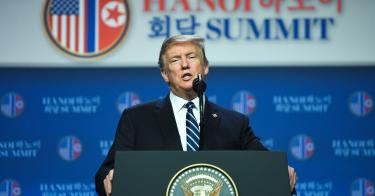This week, thousands of journalists and commentators descended on Hanoi expecting to witness history in the making. But the second summit between President Donald Trump and Kim Jong-un produced no deal, no follow-on to the limited declaration issued at the first summit, and no commitments from North Korea to denuclearize or shore up its human rights track record.
In contrast to the summit atmosphere in Singapore, there were no illusions in Vietnam. The day began with frosty words exchanged between the two leaders, with President Trump emphasizing that time is on our side and that his administration was in no rush for a deal. Kim Jong-un, responding to Washington Post reporter David Nakamura’s question about his expectations for the summit, used a double-negative, loosely translated from Korean to “I’m not pessimistic”.
While both leaders tried to downplay expectations, their Vietnamese hosts sought to establish an upbeat environment. Lining nearly every street were lampposts with the flags of the U.S., North Korea, and Vietnam. Banners inscribed with DPRK-U.S. Summit and Hanoi, the city of peace, as well as vendors selling Trump-Kim paraphernalia were tucked into the busy, bustling streets of the city.
Vietnam pulled out all of the stops hoping it could be the one to usher in a new era of peace between Washington and Pyongyang. Whispers ahead of the summit indicated that the U.S. and North Korea would sign a peace declaration.
But peace was not the result. Nor would a peace declaration necessarily render that result.
From the first moment on summit day, it was clear that things were not going as planned, and they kept getting worse at the day wore on. The tipping point came when the White House press corps was seated for lunch. The dining room was like a ghost hall, with empty seats that were supposed to have been filled by the North Korean and American delegations. Eventually the lunch and the joint signing ceremony were cancelled, as it became clear there was no agreement to sign.
President Trump, in his press conference that replaced the joint signing ceremony, indicated that the North Koreans had made a wholly unreasonable ask: “basically” complete sanctions relief in exchange for incomplete denuclearization. The president was right to walk away from such a deal.
The two sides only discussed the dismantlement of the Yongbyon nuclear research complex, and Secretary Pompeo suggested that the U.S. had called out North Korea over some of its secret nuclear and missile facilities. These facilities are confirmed by U.S. intelligence as well as open source satellite imagery analysis. To raise these concerns were a bold move on the part of U.S. negotiators.
Even if North Korea agreed to dismantle Yongbyon and some other elements of its nuclear and missile program, this would fall short of the UN-mandated requirement for sanctions relief: complete, verifiable, irreversible dismantlement of Pyongyang’s nuclear program. Nor would it satisfy the criteria for removing sanctions imposed for North Korea’s human rights violations, money laundering and sponsorship of terrorism.
It was disappointing that President Trump once again gave short shrift to North Korea’s human rights violations – even making excuses for Kim Jong-un when it came to his knowledge of the abuses experienced by once-detained, now deceased American college student, Otto Warmbier. While the Trump’s comments regarding Warmbier were regrettable, his follow-on statements highlighting horrific conditions inside political prison camps were welcome.
Now that negotiations have broken down, the administration must consider carefully its next steps. It remains to be seen whether dialogue between the two countries will resume. In the meantime, the smartest move would be for the administration to take a close look at current strategy to determine how it can best align diplomatic goals with current U.S. policy toward North Korea.
At present, there is a mismatch between priorities expressed in U.S. sanctions law and U.S. diplomatic efforts. Sanctions laws are multi-faceted and, if used, appropriately may alter the maligned behavior of Kim Jong-un. One revelation from the failed summit is that Kim Jong-un desperately seeks sanctions removal, and not for the reasons that North Korean spokesperson gave (concern for the North Korean people), but because the regime is feeling the squeeze from sanctions.
Failed talks should embolden the administration to return to a maximum pressure strategy, one that finally targets Chinese banks for the role they play in laundering money for regime. A return to maximum pressure should also reignite rhetoric the administration previously invoked condemning North Korea’s severe human rights violations. Moreover, the administration should be encouraged to refrain from high-level summitry until both sides have hammered out at the working-level a pre-negotiated deal that addresses the multi-faceted priorities of U.S. policy.
U.S. sanctions policy is designed to shift the risk calculus of the sanctioned country, encouraging it to cease violating U.S. and international laws. Diplomacy, if crafted appropriately, should build on that momentum and shift behavior through different means.
A cohesive strategy toward North Korea would recalibrate our diplomacy to reflect the values outlined in current U.S. policy – that means addressing concerns related to denuclearization, the regime’s missile program, and chemical and biological weapons, as well as concerns related to the Pyongyang’s human rights track record.
This piece originally appeared in Forbes https://www.forbes.com/sites/oliviaenos/2019/03/01/after-failed-summit-in-hanoi-where-do-we-go-from-here/#a618c7576364



